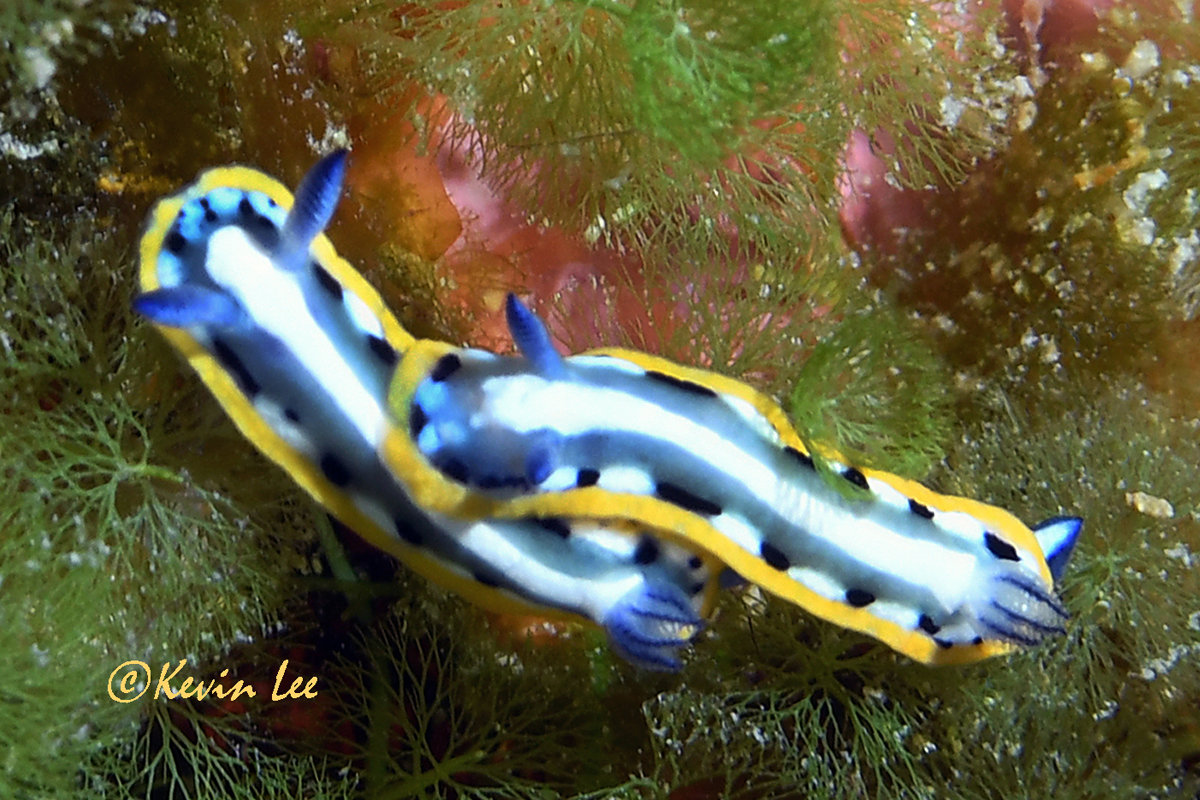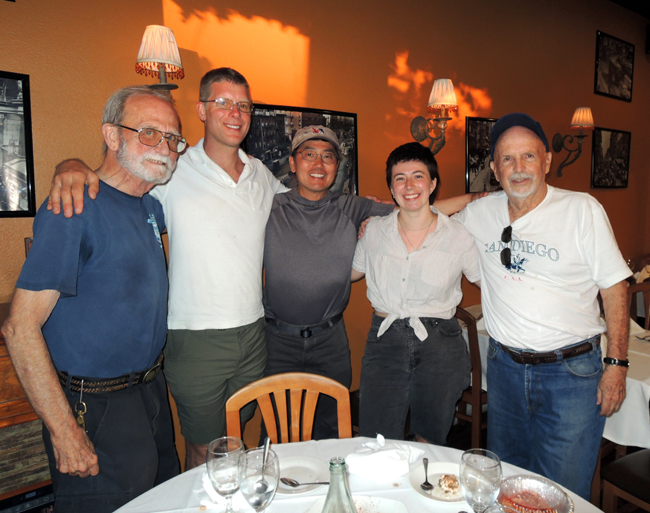 |
Felimare kempfi (Marcus, 1971)
Approximately 9.5 mm long individual, from 30 m deep
Photo by Kevin Lee, August 22, 2023
Location: Ilha do Meio (Meio Island), Fernando de Noronha Archipelago, Brazil
Coordinates: 3º 49' 05.28" S; 32º 23' 36.49" W
Felimare kempfi (Marcus, 1971)
The background dorsal color of the living slugs is opaque white. The mantle margin is rimmed with a bright orange band. In the center of the dorsum, from in front of the rhinophores to the gills, is a distinctive, longitudinal white band, lined on each side with a bluish line between the margin band and the central lines, there is a band of about seven darker blue and white spots on either side. The rhinophores and the gills are blue. In the preserved state all traces of color have faded out.
The pointed oral tentacles are grooved on the outer side. The rhinophores bear 12 leaflets. There are 9 unipinnate gills. The borders of the rhinophoral and branchial pits are smooth. The bilabiate anterior border of the foot has distinct corners, no notch.
The egg mass is a pinkish ribbon, laid on edge.
The radula is very small, 750µ by 380µ, and has 50 rows of 35 teeth per half-row. The rachis is naked. The teeth are about 40µ in length and have 3-8 denticles.
Distribution: This species has been observed from the intertidal zone to 37 m deep, throughout the Caribbean/west Atlantic region. Valdés et al., 2006, report that sightings include Florida, Puerto Rico, Brazil, Mexico, Costa Rica and Panama. [ Kevin’s animals are the first record of this species from the Brazilian Archipelago Fernando de Noronha (see García García, Domínguez Álvarez, and Troncoso, 2008). The type locality of this species is 2º 22' 00" S; 41º 51' 05" W (two specimens were dredged on 30 October 1967 from a depth of 37 m), some 1080 km northwest of Kevin Lee’s observation.
Kevin (pers. comm., 4 September 2023) wrote about his diving experience at the Archipelago: “There seems to be a dearth of sea slugs around Fernando de Noronha, a small Brazilian archipelago, about 215 miles off the northeast mainland point. My dive guides recounted seeing a single nudibranch during hundreds of dives over the past six moons. Imagine my delight and dismay, when I found two Mexichromis kempfi on my first dive! However, I only got one shot at the apple, from afar, since I was getting low on air and was at a depth of 30m/100ft. Thus, apologies, the photo is heavily cropped, soft, and doesn't reveal much detail. We were diving in a group, so I could not linger and had to hustle off to join the fast moving gang. After the dive, I was told to doff my dive gloves and not to touch anything! I immediately requested a private dive guide and paid extra for their services, including solo night dives for the next two days of diving. Alas, despite assiduous searching, none of us found another nudibranch!”
In the Introduction to the paper in which Felimare kempfi was named, Eveline wrote a very personal note (Marcus, 1971: 922) regarding the recent passing of her husband, Ernst: “This is the first report that I have published without the help of my dear husband, whose share it always was to compare the material with the literature and to edit the text, while I did the preparation, reconstruction, and drawings of the specimens. I hope that I have maintained his descriptive standards, but I am certainly not able to deal with the literature as supremely as he did.”
Originally named in the genus Chromodoris, this species has also been placed within the genera Mexichromis (based on its radular morphology) and Felimare. The original drawings by Eveline illustrate the radular teeth of both Chromodoris kempfi and Hypselodoris marci. The morphological shapes are, respectively, characteristic of Mexichromis (see figure 38) and Hypselodoris (see Figure 39). Since DNA studies along with traditional dissections usually indicate subtle differences shared by members of the genus, it seems further research is needed to properly determine the phylogeny of these species.
A BIG THANK YOU to Kevin Lee for his generosity and skill, providing text information and the opening photograph.
Literature Cited
García García, Francisco J., Marta Domínguez Álvarez & Jesús S. Troncoso. 2008. Opistobranquios de Brasil. Descripción y Distribución de Opistobranquios de Litoral de Brasil y del Archipiélago Fernando de Noronha. Feito, S.L. 215 pp.
Marcus, Eveline. 1971. Opisthobranchs from northern Brazil. Bulletin of Marine Science 20(4): 922-951.
Valdés, Ángel, Jeff Hamann, David W. Behrens & Anne DuPont. 2006. Caribbean Sea Slugs. A Field Guide to the Opisthobranch Mollusks from the Tropical Northwestern Atlantic. Sea Challengers Natural History Books, Etc., Gig Harbor, Washington. Vii + 289 pp.
Imperial Beach, Calif
Oct., 2023
Send Hans email at hansmarvida@sbcglobal.net
Hans Bertsch, Craig Hoover, Kevin Lee, Tori Bolin, and Mike Miller at recent La Jolla dinner party graciously hosted by Kevin
 |
|
